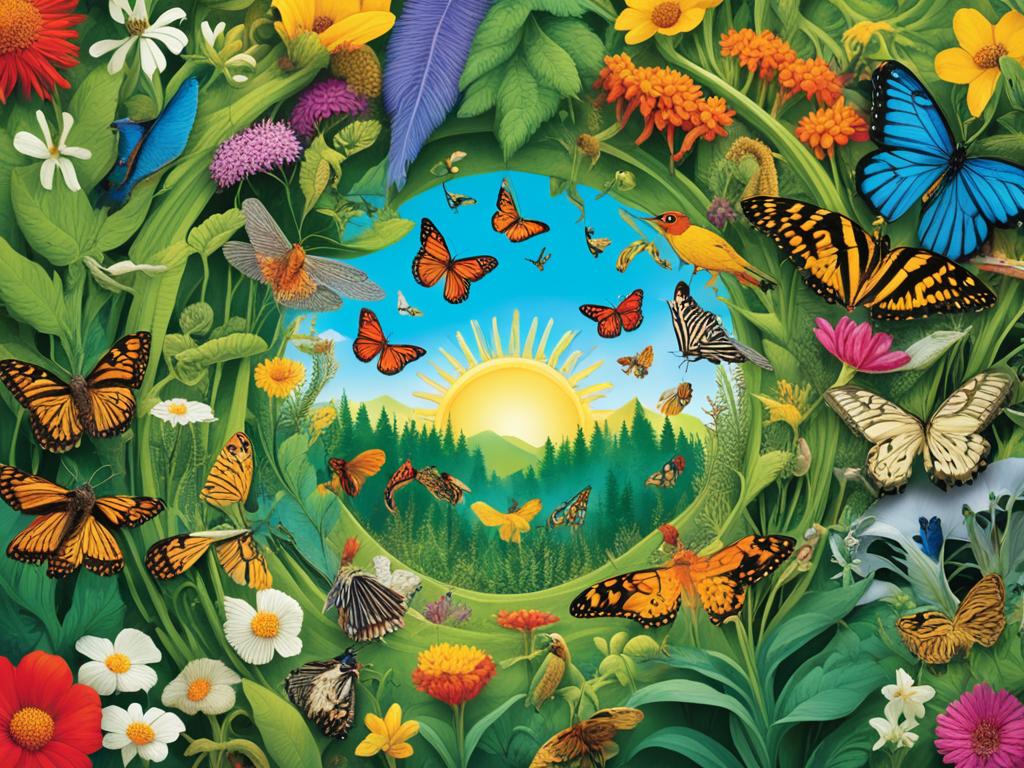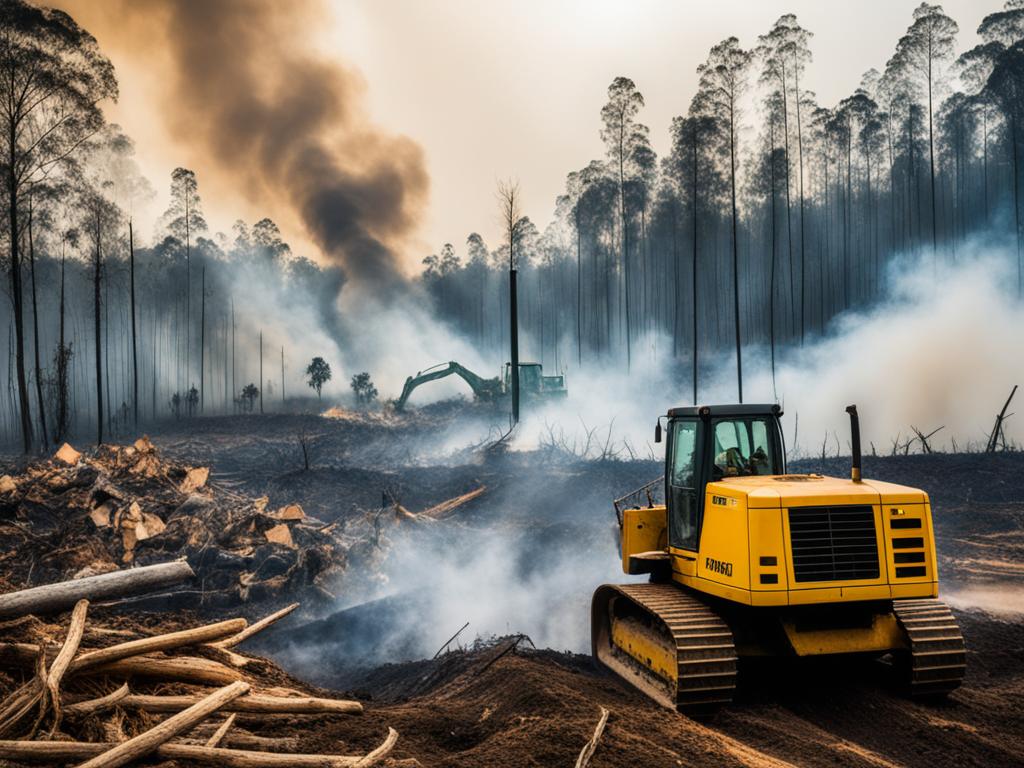Biodiversity is all about the many types of life on Earth. It is key to keeping our ecosystems healthy and working well. Ecosystems do a lot for us, like giving us clean air and water, making sure we have enough food, and even helping to keep diseases in check.
But, sadly, we are losing biodiversity fast. This loss is having big effects on our health around the globe. We need to work hard to protect the variety of life on Earth. This way, we can safeguard our natural resources for the future.
Key Takeaways
- Biodiversity is essential for the proper functioning and resilience of ecosystems.
- Healthy, diverse ecosystems provide vital ecosystem services that support human health and well-being.
- Biodiversity loss can have significant direct and indirect impacts on human health, including through disruptions to food production, disease regulation, and access to natural resources.
- Understanding the role of species richness and genetic variation in ecosystem health is crucial for developing effective conservation strategies.
- Integrating biodiversity conservation into broader ecosystem management approaches is essential for ensuring the long-term sustainability of our natural resources.
What is Biodiversity?
Biodiversity covers the variety of living organisms. It’s vital for ecosystems to work well. This diversity of species and genetic diversity within species matter a lot. So does the diversity of ecosystems. Biodiversity varies all life, from tiny organisms to big animals. It also means varied genetic traits in organisms and how things live together in natural places.
Defining Biodiversity
Biodiversity or biological diversity means the richness and variety of living organisms on Earth. It includes ecological diversity, species richness, and genetic variation. These are key for keeping the environment safe and habitats lasting.
Levels of Biodiversity
Biodiversity is seen in genetic diversity, species diversity, and ecosystem diversity. Genetic diversity is about differences in genes in a species. Species diversity shows the number and kinds of species. And ecosystem diversity is the mix of ecosystems like forests and wetlands. All these types of biodiversity help life withstand change, keep food webs steady, and offer services that help people.
Importance of Biodiversity for Ecosystem Functioning
Biodiversity is key for ecosystems to work well and provide services we need. It includes making food, helping prevent disease, and even controlling the climate. The beauty of nature and activities like hiking are also part of this. It shows how important biodiversity is for us.
Provisioning Services of Biodiversity
Many things we need come from biodiversity. Different plants and animals give us food, medicine, and materials. This makes our lives richer and healthier. The more types of life we have, the more resilient our systems become.
Regulating Services of Biodiversity
Biodiversity also keeps ecosystems stable. It limits the spread of diseases and helps after disasters. This includes things like controlling water supply, which is vital.
Cultural Services of Biodiversity
Nature does more than meet our basic needs. It also inspires us and keeps us mentally and physically healthy. Many people find deep meaning in nature and its variety. It taps into their culture and beliefs.
By seeing how much we get from biodiversity, we learn to protect it better. Its loss would hurt us in many ways. That’s why saving nature is crucial for our future and well-being.

The Role of Biodiversity in Ecosystem Health
Biodiversity is crucial for the health and strength of ecosystems. Ecosystems with many different species are more stable. They can bounce back from disease, bad weather, or habitat destruction. This happens because each species plays a unique part. It helps in case something goes wrong. Diverse ecosystems also work better. They are more productive and efficient. Each species finds its own place and uses resources differently. This boosts an ecosystem’s performance. Moreover, genetic diversity lets species adapt to change. It keeps ecosystems healthy in the long run. So, keeping biodiversity alive is vital. It ensures nature can keep helping us in many ways.
Biodiversity is key for dealing with problems and keeping the food chain stable. This helps keep ecosystems diverse and full of life. Protecting nature and its creatures is essential. It ensures we still get what we need from the environment. This ranges from pure air and water to fighting off diseases.
Threats to Biodiversity and Their Impact on Ecosystems
Biodiversity, the variety of life on Earth, is critical for ecosystems to be healthy and robust. Sadly, people’s actions are putting it at risk. If we don’t act, many negative effects will hit the services nature gives to people.
Habitat Loss and Fragmentation
Habitat loss is a big reason why many species are disappearing. Humans are clearing forests, building cities, and making farms bigger. This makes natural homes smaller and further apart. As a result, many plants and animals find it hard to live, which can lead to them dying out. This breaks the links between different parts of nature, affecting how many species can survive, and the health of the entire ecosystem.
Climate Change
Climate change is making the world warmer and weather more extreme. This is a big issue for species and ecosystems. Plants and animals have to find new homes or ways to survive these changes. But not all can, leading to a loss of diversity and a shaky balance in ecosystems that affects everyone.
Invasive Species
Bringing in non-native species can wreak havoc on local ecosystems. This happens a lot through global trade and travel. The new species might eat other species, or change how things work in their new home. This can lead to fewer species overall and less stable ecosystems, which is bad news for plants, animals, and people.
Pollution
Pollution is also a major threat. Dirty air, water, and soil can harm living things directly and indirectly. It can make it harder for plants and animals to live and survive. When pollution messes with nature’s processes, like cleaning water, people’s health and livelihoods are also affected.
As these threats mount, the damage to ecosystems and the benefits they give us increases. Solving these problems means everyone needs to work together. We must make sure that saving biodiversity is part of all our plans and actions.

Biodiversity and Human Health
The link between biodiversity and human health is complex. It shows why we must care for diverse ecosystems. They offer food, medicine, and peace of mind. To keep people healthy, we must protect ecological diversity, species richness, and genetic variation.
Nutritional Benefits of Biodiversity
Many plant and animal species give us key nutrients for good health. This variety makes our meals balanced and nutritious. Biodiversity helps ensure we have enough to eat and supports farming and natural resources.
Medicinal Resources from Biodiversity
Nature’s many organisms offer a treasure trove of healing plants and drugs. If we lose this biodiversity, we risk missing out on future cures. This highlights the need to protect habitats and the environment.
Mental Health Benefits of Exposure to Biodiversity
Being in natural areas boosts our mood and brainpower. It helps us handle stress better and stay healthy. Biodiversity plays a key role in our mental health and enjoyment of life.
Understanding the many ways biodiversity benefits us motivates us to protect it better. We need to value and restore natural areas. This way, they can keep supporting our health and well-being for years to come.
Biodiversity and Disease Regulation
Biodiversity is key in managing how infectious diseases spread. The variety of species, especially predators and competitors, controls pests like mosquitoes and rodents. Also, diverse ecosystems recover better from disturbances. This reduces the chances of new diseases appearing and spreading.
Biodiversity’s Role in Controlling Infectious Diseases
The ecological diversity in an area can naturally resist infectious diseases. A high number of different species limits the growth of pests. This is because their enemies help keep them in check. Thus, the ecosystem remains stable, benefiting human health needs like food and genetic diversity.
Biodiversity and Emerging Diseases
Losing habitats and climate change can create new diseases or worsen existing ones. Tackling environmental protection is crucial to prevent this. Efforts to preserve habitats maintain the natural order. This reduces the risk of diseases jumping from animals to people. We must deeply grasp how biodiversity and diseases are linked. This knowledge is vital for preventing health issues caused by losing biodiversity.
Economic Benefits of Biodiversity
Biodiversity brings big bucks. It supports food, water, and more. It also fights climate change and keeps us healthy. Diverse nature places also give us culture and fun. To keep making money, we need to take care of the Earth’s ecosystems.
Ecosystem Services Provided by Biodiversity
Nature is rich in value. The U.S. gets $3 billion from 6 million tons of wild food. Fixing chemical messes the nature way saves $135 billion each year worldwide. In the U.S., nature brings $319 billion in benefits yearly. Globally, this hits $2,928 billion.
Biodiversity and Sustainable Development
Organisms’ different genes are gold. They make new drugs, farm stuff, and more. Protecting these genes benefits us long-term. Many jobs and industries rely on nature. This shows how important it is to care for our planet.
| Sector | Dependency on Biodiversity |
|---|---|
| Agribusiness | Needs bees for crops. Less biodiversity means trouble growing food. |
| Tourism and Hospitality | Thrives on places like coral reefs. |
| Automotive | Uses nature for car materials, like rubber and leather. |
| Consumer Goods | Uses nature for new materials and goods. |
Many big businesses see the need to protect nature. They affect or depend on it. People want eco-friendly products more. So, companies are turning to nature. Protecting biodiversity makes them look good and keeps customers happy.
Governments worldwide are urging for biodiversity protection. They offer money for green efforts. Investing in nature helps companies last longer and grow better. It also drives innovation.
Conservation Efforts and Biodiversity Protection
People all around the globe recognize how important it is to protect biodiversity. They do many things to keep nature safe and let animals thrive. Protected areas like national parks and reserves help a lot. They protect living spaces and stop different species from disappearing. These areas are not just for animals. They also help people by giving them places to enjoy nature and keep their cultures alive.
Protected Areas and National Parks
National parks and reserves are key to keeping our environment safe. They make sure there are lots of different plants and animals by giving them a safe place to live. By stopping too much human activity and building, these areas stay strong and keep the food chain in balance. This helps the whole environment stay healthy.
International Agreements and Policies
Many countries work together to protect nature. They have formed agreements, like the Convention on Biological Diversity, to help. These agreements are meant to keep the different types of life on Earth from going away. Their goal is to protect the services nature gives us so we can all live well.

Integrating Biodiversity Conservation into Ecosystem Management
Efforts to save our wildlife must fit into bigger plans for managing our world. Approaches that focus on ecosystems show how everything is connected. They help make sure resources from nature can last a long time. This means thinking about saving different species when using land or taking out resources.
Ecosystem-Based Management Approaches
Thinking about ecosystems as a whole means looking at how everything affects each other. This way makes it easier to deal with the big reasons why we’re losing plants and animals. It’s not just about saving one species or one area, but making the whole system strong.
This approach sees nature as connected parts. By saving different life forms, the whole system gets stronger.
Involving Local Communities in Conservation
Working with the people who live near nature is a big part of saving it. These folks often know a lot about how to care for the land and seas. Their ways of life can be a key part of keeping things in balance.
Creating teams with these local experts makes our efforts better and more fitting to their culture. It also helps ensure everyone benefits fairly and helps to keep nature safe.
To really save nature, we need a team effort that includes everyone. This way, saving different plants and animals becomes a part of everyday choices. It means making decisions that are good for nature and that include the people who live nearby.
The Future of Biodiversity and Ecosystem Health
The future of biodiversity and ecosystem health depends on our actions now. We face serious threats like habitat loss, climate change, and pollution. To fight these, we must focus on conserving and restoring various natural habitats.
This effort means many things. We need to grow protected areas, manage lands and resources wisely, and think about biodiversity in all we do. It’s not just about nature—it’s about our future too.
Biodiversity is key to our planet’s health and resilience. It’s like a colorful Earth quilt that must stay intact for all living things. We need to push for better rules across borders to protect our biodiversity. This is because losing species means we might miss out on new medicines often.
Keeping our biodiversity strong is vital. It means our ecosystems can keep giving us essential services. These range from food and water to keeping our climate steady and our cultures alive. We must choose to save and bring back various nature spots for our planet’s ecological diversity and species richness. This will help everything and everyone on Earth to keep going strong.
Source Links
- https://www.who.int/news-room/fact-sheets/detail/biodiversity-and-health
- https://www.usgs.gov/news/biodiversity-critical-maintaining-healthy-ecosystems
- https://www.amnh.org/research/center-for-biodiversity-conservation/what-is-biodiversity
- https://www.ncbi.nlm.nih.gov/pmc/articles/PMC9300022/
- https://www.nationalgeographic.org/encyclopedia/biodiversity/
- https://www.nps.gov/articles/parksciencev31-n1_buttke_etal-htm.htm
- https://www.ncbi.nlm.nih.gov/pmc/articles/PMC7121084/
- https://www.who.int/docs/default-source/climate-change/qa-infectiousdiseases-who.pdf?sfvrsn=3a624917_3
- https://library.weconservepa.org/guides/95-economic-benefits-of-biodiversity
- http://sensiba.com/resources/insights/the-economic-benefits-of-biodiversity/
- https://www.resources.org/archives/the-economics-of-biodiversity/
- https://ccaps.umn.edu/story/6-reasons-why-biodiversity-conservation-important
- https://www.natureandculture.org/biodiversity-understanding-its-significance-and-conservation/
- https://www.cbd.int/doc/c/501c/4df1/369d06630c901cd02d4f99c7/sbstta-21-09-en.pdf
- https://unsceb.org/sites/default/files/2022-01/Biodiversity_Common_Approach_50+_ways_to_integrate_biodiversity_and_nature-based_solutions.pdf
- https://www.frontiersin.org/articles/10.3389/fevo.2022.1086408
- https://www.ncbi.nlm.nih.gov/pmc/articles/PMC5735771/
- https://www2.gov.bc.ca/gov/content/environment/plants-animals-ecosystems/biodiversity


